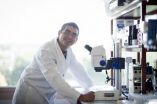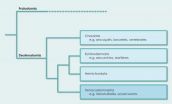(Press-News.org) Children with hip and thigh implants designed to help heal a broken bone or correct other bone conditions are at risk for subsequent fractures of the very bones that the implants were intended to treat, according to new research from Johns Hopkins Children's Center.
Findings of the Johns Hopkins study, based on an analysis of more than 7,500 pediatric bone implants performed at Hopkins over 15 years, will be presented Feb. 16 at the annual meeting of the American Academy of Orthopaedic Surgeons.
Although the absolute risk among the patients was relatively small — nine out of 1,000 hip and thigh implants were linked to hip and thigh fractures — it was 15 times higher than the risk for implant-related fractures in other bones, the researchers say. They urge orthopedic surgeons to carefully consider removing the implants a few years after surgery or once the bone has healed completely.
Implant related fractures are believed to stem from the pressure and stress that the implant exerts on the bone, especially in patients whose bones are still growing and in those with already weakened or brittle bones from preexisting conditions such as cerebral palsy and some rare skeletal syndromes. Indeed, most of the 25 implant-related fractures in the study occurred in children with such diagnoses.
The investigators note that hip and thigh bones experience the highest stress because their shape changes rapidly during growth, so removing these implants may be especially important for children.
"Removing the implant early and as soon as the bone heals is a wise consideration for all children with hip and thigh implants, but even more so for patients with already vulnerable bone structure," says senior investigator Paul Sponseller, M.D., M.B.A., director of orthopedic surgery at Hopkins Children's.
Thigh implants carried the highest risk — 20 of the 25 fractures observed in the study involved hip and/or thigh implants, or nine fractures per 1,000 such implants. The overall risk for fractures caused by implants in any bone was three per 1,000, while the risk of fracture was less than one per 1,000 in the hand, arm, forearm, leg, ankle and foot bones.
Low-risk implants in healthy children are best left in, the researchers add, because the surgical risks of removing them may outweigh the benefits.
"To remove or not remove an otherwise asymptomatic implant has been a long-standing question in orthopedic surgery, and we hope that our findings will help surgeons and patients make such decisions," Sponseller says.
The average time between implant insertion and fracture was 2.6 years.
INFORMATION:
Co-investigators on the research included Amit Jain, B.S., Arabella Leet, M.D., and Michael Ain, M.D., all of Hopkins, and Gurkan Erkula, M.D., formerly of Hopkins.
Related:
Paul Sponseller
http://www.hopkinschildrens.org/Paul-Sponseller-MD.aspx
American Academy of Orthopaedic Surgeons http://www.aaos.org
END
Scientists from the Walter and Eliza Hall Institute have begun to unravel how blood stem cells regenerate themselves, identifying a key gene required for the process.
The discovery that the Erg gene is vitally important to blood stem cells' unique ability to self-renew could give scientists new opportunities to use blood stem cells for tissue repair, transplantation and other therapeutic applications.
Professor Doug Hilton, Dr Samir Taoudi and colleagues from the institute's Molecular Medicine and Cancer and Haematology divisions led the study. Dr Taoudi said the research ...
An international team of scientists including Albert Poustka from the Max Planck Institute for Molecular Genetics in Berlin has discovered that Xenoturbellida and the acoelomorph worms, both simple marine worms, are more closely related to complex organisms like humans and sea urchins than was previously assumed. As a result they have made a major revision to the phylogenetic history of animals. Up to now, the acoelomate worms were viewed as the crucial link between simple animals like sponges and jellyfish and more complex organisms. It has now emerged that these animals ...
VIDEO:
To test their capacity to learn, the mice are trained to find an underwater platform which is not visible to them from the edge of a water basin. The swimming...
Click here for more information.
Amyloid-beta and tau protein deposits in the brain are characteristic features of Alzheimer disease. The effect on the hippocampus, the area of the brain that plays a central role in learning and memory, is particularly severe. However, it appears that the toxic effect of tau ...
Scientists have discovered that insects contain atomic clues as to the habitats in which they are most able to survive. The research has important implications for predicting the effects of climate change on the insects, which make up three-quarters of the animal kingdom.
Applying a method previously only used to examine the possible effects of climate change on plants, scientists from the University of Cambridge can now determine the climatic tolerances of individual insects. Their research was published today, 16 February, in the scientific journal Biology Letters.
Because ...
Ebstein's anomaly is a rare congenital valvular heart disease. Now, in patients with this disease, researchers of the Academic Medical Center Amsterdam in the Netherlands, the University of Newcastle, UK and the Max Delbrück Center for Molecular Medicine (MDC) Berlin-Buch have identified mutations in a gene which plays an important role in the structure of the heart. The researchers hope that these findings will lead to faster diagnosis and novel, more specifically targeted treatment methods (Circulation Cardiovascular Genetics, DOI: 10.1161/CIRCGENETICS.110.957985)*.
Ebstein's ...
Researchers at Toshiba are working on a way of finding clusters of like-minded bloggers and others online using "social annotations". Social annotations are the tags and keywords, the comments and feedback that users, both content creators and others associate with their content. Their three-step approach could help you home in on people in a particular area of expertise much more efficiently and reliably than simply following search engine results. The same tools might also be used in targeted marketing.
Users of photo gallery sites, such as Flickr (http://www.flickr.com/) ...
The first study of its kind in the world — involving 336 children aged between six months and 16 years old — has shown that installing a water softener for three months brings no additional relief for eczema sufferers.
Up to one fifth of all children of school age have eczema, along with about one in 12 of the adult population. Anecdotal reports from patients have suggested that hard water may worsen atopic eczema. Population surveys have also suggested a possible link between atopic eczema prevalence and the degree of water hardness.
It had been hoped that water softeners ...
Philadelphia, PA, 16 February 2011 - Lithium, introduced in the late 1940's, was the first "wonder drug" in psychiatry. It was the first medication treatment for the manic and depressive episodes of bipolar disorder and it remains among one of the most effective treatments for this disorder.
In the past 15 years, as molecular mechanisms underlying the treatment of bipolar disorder began to emerge, basic research studies conducted in animals began to identify neuroprotective and perhaps neurotrophic effects of this important medication.
The identification of these ...
Pioneering Spanish provinces in terms of early prevention of breast cancer, such as Navarre and the Basque Country, record lower death rates, although the trend is towards the figures levelling out all over Spain. These are the results of a study carried out by Spanish researchers, which analyses the number of women who died between 1975 and 2005.
"The Canary Islands, Balearic Islands, some parts of Catalonia, Valencia and Murcia, as well as the south west region, have higher breast cancer death rates, although there is a trend towards the geographical differences disappearing", ...
WASHINGTON—February 16, 2011— Research!America's board chair, former Congressman John Edward Porter, and president, Mary Woolley, thanked President Obama for prioritizing medical, health and scientific research in his FY2012 budget proposal.
The president's budget includes $31.829 billion for the National Institutes of Health ($745 million increase over 2010); $7.8 billion for the National Science Foundation ($1.2 billion increase over 2010); and $2.747 billion for the Food and Drug Administration ($382 million increase over 2010). The budget proposes $5.8 billion for ...

